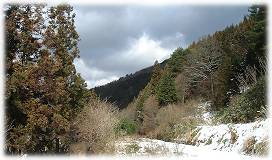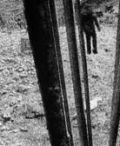
November 20, 2008
Brent Swancer delivers a smashingly good posting as today’s guest blogger:
Hairy bipeds are reported from all over the world. North America has its Sasquatch and Skunk Apes, the Himalayas its Yeti, Southeast Asia its Orang Pendek. Could there be a similar such creature inhabiting the remote mountains of Japan?
The “Japanese Bigfoot” is commonly referred to as the Hibagon, said to lurk in the forests of Mt. Hiba in Northern Hiroshima, from which it gains its namesake, as well as its surrounding areas.
Various popular illustrations of the appearance of Hibagon:
The Hibagon is a reddish brown or black in color, sometimes reported as having a patch of white fur on its chest or arms.It is said to be a foul smelling creature, with a face covered in bristles, a snub nose, and glaring, intelligent eyes. The face is sometimes said to be long and somewhat protruding rather than flat like a human’s, and the head is often reported as proportionately large, and shaped somewhat like an inverted triangle.
The Hibagon is much smaller than its North American counterpart, being most commonly reported as around 5 feet in height and estimated as weighing about 180 pounds. In many respects, the Hibagon is more ape-like than the Sasquatch as well. It is often described as looking like a gorilla or giant monkey, and although it is most often seen moving bipedally, many reports tell of the creature moving about on all fours quite easily. Some eyewitnesses even claim the animal was hopping along “like a monkey.” Other notable features are the Hibagon’s apparent lack of fear of people and the absence of any sort of vocalizations in the reports.
The Hibagon is mostly known from a series of sightings lasting from 1970 to 1982. Probably the first Hibagon sighting account occurred in early 1970, when a group of elementary school students out picking wild mushrooms in the forests of Mt. Hiba were terrified to come across an ape-like creature crashing through brush nearby.
A gallery of the various pieces of evidence presented for Hibagon:

That same year, in July 1970, the creature was spotted again by a utilities truck driver. The driver reported seeing a gorilla-like creature on two legs stride across a field near a dam, run across the road, and disappear into the forest. Several days later, on July 23rd 1970, the creature appeared again, this time out of brush and long grass in front of a surprised farmer, who described the Hibagon as being as tall as an average man, covered in black fur, and having a grotesque face with piercing, intelligent eyes. The Hibagon was also sighted walking through a rice paddy in the town of Saijo around the same time. In December of that same year, strange tracks of the alleged creature measuring 21 centimeters in length were found in the snow of Mt. Hiba. More tracks would be uncovered in the following years, and one of the longest trackways stretched on for 300 meters.
By this time, the reports were becoming well-known and well publicized in the media, while at the same time the rural residents of the area were growing increasingly uneasy about the strange animal being seen in their forests. Sightings continued, and area residents became so uneasy that the county now known as Saijo Shobara actually set up a department to deal with the phenomena. In addition to documenting eyewitness accounts and trying to get to the bottom of what was going on, the department also launched patrols around the area in hopes of finding whatever was causing the reports. Kobe University conducted an investigation of the area in 1972 to try and find physical evidence of the Hibagon, and police managed to make plaster casts at a construction site of some tracks allegedly made by the creature. No evidence was turned up by the University, and the tracks were found to be inconclusive.
Sightings continued through 1972 and 73, almost always during summer months, and in 1974 there was a significant spike in the amounts of reports. One such sighting occurred on August 15, 1974 when a motorist spotted a large, blackish animal walking near the road on four legs. When the creature sensed the approaching vehicle, it is reported as standing up and walking along on two legs. The shocked driver then stopped the car and snapped a photo of the creature trying to hide itself behind a persimmon tree. The photo is of poor quality, a blobsquatch in every sense, yet it received wide publicity and became probably the most famous photo of a Hibagon (see directly below).
Other sightings in 1974 include a Hibagon that was spotted crossing a road on June 20, 1974. The driver described it as moving along in a series of hopping leaps. On July 15, 1974, a woman saw one near her house and described it as very ape-like, like a gorilla walking around on two legs, and about 1.6 meters tall. There was even video footage taken of one walking along a remote mountain road, however the footage is blurry and of poor quality. Many tracks were also discovered in the year of 1974, including a series of prints found on August 21 in a mountain valley. The footprints were 30 cm long, which is not large for a sasquatch but some of the biggest prints found for an alleged Hibagon.
After the surge of eyewitness accounts in 1974, sightings of the Hibagon dropped off almost completely until 1980, when one was seen fleeing across a river with a bounding gait near the town of Yamano, where it became known as the “Yamagon.” It was spotted in the same area again in 1981 on a road near a health center, but perhaps the most remarkable sighting of the time occurred in 1982 in Mitsugi, which is located about 30km west of Yamano. In this report, the Hibagon was described as being more along the lines of sasquatch in size, estimated at 2m tall, but the most bizarre feature of the account was that it was said to be holding what looked like some sort of stone tool like an axe. This is the only account of a Hibagon being that large or wielding any sort of tool or weapon.
After 1982, sightings abruptly stopped, and the Hibagon seemed to just fall off the face of the Earth. There are practically no reliable reports of the creature after this time.
So what was it that people were seeing?
Theories abound about what the Hibagon could be. Perhaps the most common such theory is that the culprit was an elderly or infirm Japanese macaque that had lost its group and gone solo. This would fit in with the reddish brown coloration of some of the reports, as well as the oft mentioned tendency for the Hibagon to walk along on all fours and its ape-like appearance. This might even explain a limping shuffle mentioned in a few accounts, which would fit in with an injured animal. One of the problems with this idea is that Japanese macaques do not get nearly as large as the Hibagon is reported as being, and macaques would not match the black coloration reported by some eyewitnesses. Japanese macaques are also fairly common in Japan, and would likely be recognized by the locals as such.
Another idea is that the creature was an escaped Asiatic black bear. This species of bear has a swath of white fur on its chest, a feature noted in some Hibagon reports, and of course bears are able of stints of bipedal locomotion. The Asiatic black bear is also a bit different in appearance than the naturally occurring black bears of Japan, and the long face described in some Hibagon reports would fit in with a bear.
There is also speculation that an escaped great ape, such as an orangutan, could be the culprit. This would fit in many ways appearance-wise, and there is one old newspaper report that I know of concerning smuggled orangutans escaping into the wild. However, orangutans are very arboreal creatures, and there are no reports of Hibagon in trees. Orangutans would also not find it easy to survive in the wild there, since the temperatures can be very cold there in this area.
Yet another theory is that what was seen was not animals at all, but rather “Yajin”, feral humans or mountain men who have shunned society to live alone in the wilderness. Perhaps the sightings were even caused by a mix of all of the above.
Or was the Hibagon something else entirely? Is it possible that a new type of hairy bipedal creature once lived, or maybe even still lives, in the remote mountains of the area? Some proponents have speculated that the rash of sightings that occurred during the 70s coincided with an increase of hunting in the area, which could have driven some of the creatures down from their habitat. The animals that were seen could also have been sick or wounded individuals that had wandered from where they usually live, perhaps in search of food. A few reports describe the animal as moving along with a shuffling gait or a limp, which has lead to speculation that at least one of the alleged creatures was injured, so?this could possibly explain these reports. Some have even suggested that the Hibagon that were sighted could have represented the last of a very rare species and that they are now extinct. Could the Hibagon been a new, undocumented creature?
Whatever the Hibagon was or is, it still lives on in the memory of the area’s residents. There are many regional, Hibagon related goods such as “Hibagon eggs” (which are actually Japanese sweet bean cakes), Hibagon “donburi” (a type of Japanese food), Hibagon company mascots, signs announcing the presence of Hibagon in the area, and even a giant Hibagon statue near one highway. The Hibagon’s image can be found everywhere and is a fixture of the local culture in some towns of the area.


“Hibagon eggs” that are actually a type of Japanese sweet bean dumpling.

A sign advertising “Hibagon-don,” a type of “donburi” which is a Japanese dish.

A truck for a company with a Hibagon as its mascot.

A road sign announcing the presence of Hibagon in the area.
What was the Hibagon? Where is it now? Perhaps we will never know.
About Loren Coleman
Loren Coleman is one of the world’s leading cryptozoologists, some say “the” leading living cryptozoologist. Certainly, he is acknowledged as the current living American researcher and writer who has most popularized cryptozoology in the late 20th and early 21st centuries.
Starting his fieldwork and investigations in 1960, after traveling and trekking extensively in pursuit of cryptozoological mysteries, Coleman began writing to share his experiences in 1969. An honorary member of Ivan T. Sanderson’s Society for the Investigation of the Unexplained in the 1970s, Coleman has been bestowed with similar honorary memberships of the North Idaho College Cryptozoology Club in 1983, and in subsequent years, that of the British Columbia Scientific Cryptozoology Club, CryptoSafari International, and other international organizations. He was also a Life Member and Benefactor of the International Society of Cryptozoology (now-defunct).
Loren Coleman’s daily blog, as a member of the Cryptomundo Team, served as an ongoing avenue of communication for the ever-growing body of cryptozoo news from 2005 through 2013. He returned as an infrequent contributor beginning Halloween week of 2015.
Coleman is the founder in 2003, and current director of the International Cryptozoology Museum in Portland, Maine.
Filed under Abominable Snowman, Artifacts, Bigfoot, Cryptomundo Exclusive, Cryptotourism, CryptoZoo News, Cryptozoologists, Cryptozoology, Evidence, Eyewitness Accounts, Folklore, Guest Blog, Pop Culture, Proto-Pygmies, Replica Cryptia, Yeren, Yeti, Yowie